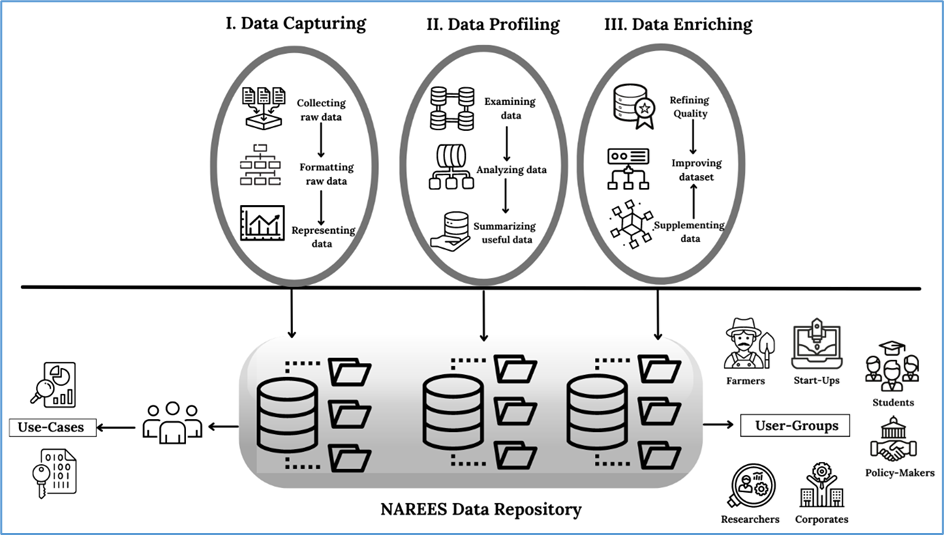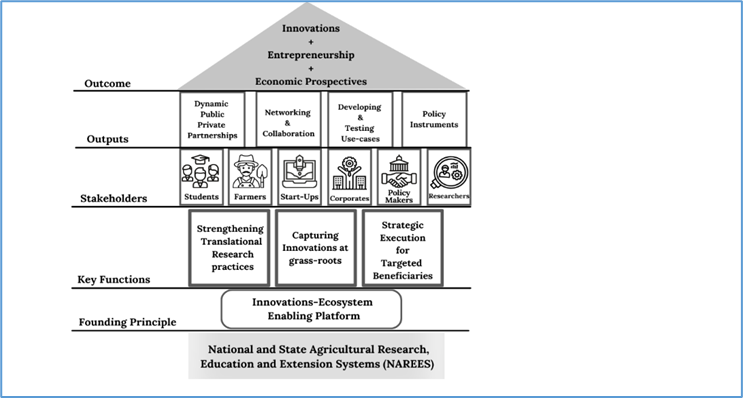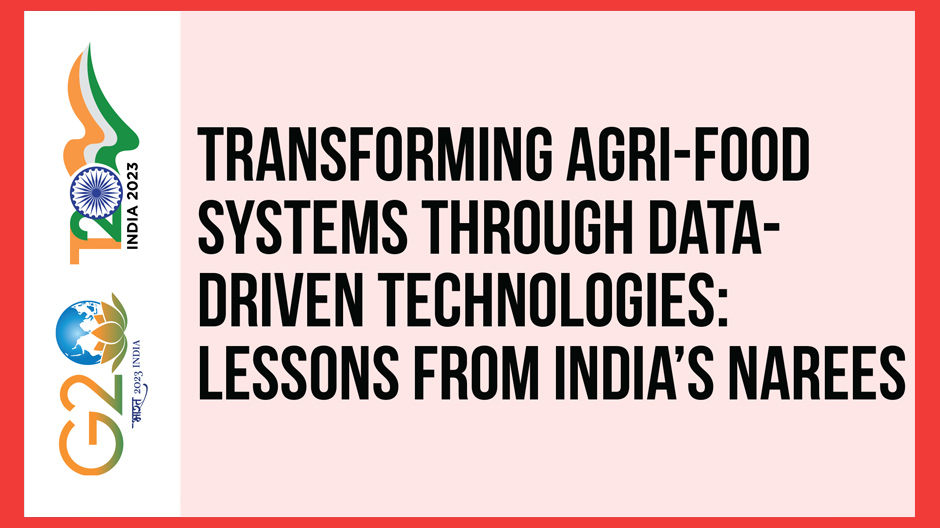Task Force 6: Accelerating SDGs: Exploring New Pathways to the 2030 Agenda
Data-driven technologies are enabling rapid changes in agricultural food production systems. They have the potential to transform farming methods and bring about sustainable resource management, increased levels of productivity, sustainability, and efficiency. For the last seven decades, India’s National and State Agricultural Research, Education and Extension System (NAREES) has facilitated the improvement of agricultural production for achieving food security in India. With its inherent advantage of reach across the country, it can also play an important role in catalysing the deployment of data-driven technologies and innovations in agri-food production systems. This Policy Brief presents a model for NAREES to adopt and use data-driven technologies for building a sustainable agri-based economy in India. It recommends that this base model be extended across other G20 countries with similar ecosystems.
1. The Challenge
India’s agricultural sector accounted for 20 percent of gross domestic product (GDP) in 2020-21 despite the COVID-19 pandemic that year.[1],[2] This was mainly due to timely corrective and innovative interventions at the operational levels. Even so, the disruptions in food supply in the early phase of the pandemic due to market closures and migration of workers clearly brought out the need to streamline processes through mechanisation and to create digital platforms for seamless transactions. The logistics and distribution vulnerabilities of supply chains also spurred new innovative, local-based models. More compact public distribution systems[3] and timely public policy decision-making emerged as other crucial factors[4] in developing new supply chain models with a focus on sustainability. The sector is currently poised to grow at a compound annual growth rate (CAGR) of 4.9 percent[5] in the period 2022-2028, with an estimated market value of INR 89,300 billion by 2023.
With the global population set to rise to 10 billion by 2050, there is urgent need for more innovative agricultural practices. Systemic challenges of soil nutrient depletion, reduced natural resources, land degradation, food losses/waste and climate change continue to pose multiple problems for food producers. The potential of smart, precise, data-driven computational applications to support and strengthen agriculture provides new opportunities. The approaches include more connected farm-to-market supply chains; financial and digital inclusivity for smallholder farmers; assuring safety and trust in production systems; real-time monitoring of environmental impacts; improving productivity and efficiency through farm mechanisation; managing food wastage through digital enablement of storage and logistics infrastructure; and infusing smart risk management of nature-related uncertainties.
Data-driven agriculture can also mitigate several challenges, especially in areas where farming is a means of survival and stakeholders struggle with environmental and climate adversities. It can make a real difference to profitability.[6] However, structural challenges such as lack of upfront financial capital for adoption of digital technologies, market risks, and the time lag to reach farmers and build their digital literacy capacities need to be considered while catalysing a new-age data-driven agricultural revolution.
2. The G20’s Role
India’s National and State Agricultural Research, Education and Extension System (NAREES) has had remarkable success in training scientists and providing new farming technologies[7] such as high-yielding varieties of crops, better inputs, and improved cropping practices. These initiatives integrated into the national agricultural education system, research and extension, and developed into a mutually reinforcing model.[8] As a result, stakeholders have great trust in NAREES. India’s green revolution made the country a significant global food producer and a model for the Global South region to emulate. Thus, India’s use of emerging technologies in agri-food systems can also be emulated by other G20 economies. The primary focus should be to elevate the agri-food sector from rural-survival level to rural livelihood-generating business enterprise level, with transformational data-driven technologies. This will help reach the UN Sustainable Development Goals (SDGs) faster, providing higher food and nutritional security, greater climate resilience, and enhanced livelihoods for all.
Emerging Model of Data-Driven Agriculture in NAREES
Big Data analytics has the capacity to transform the agricultural sector. A strategic integration of complementary software and tools, with datasets collected from various sources, would help in analysing real-time field data towards making more informed and smart farming decisions. Large sets of historical data are required for this—to discover cause-and-effect patterns and recognise and anticipate trends. Such datasets, well validated, will help developers innovate and increase operational efficiency, brand value and lifetime applicability.
India’s NAREES already has dedicated repositories of large sets of historical data. There is thus an opportunity for India to develop data policy and protocols of data-sharing with agri-tech start-ups and businesses. A robust and comprehensive quality management protocol for data sets in NAREES (see Fig. 1) customised for applicability to the agri-food sector, can consolidate the available data repositories. Initiatives like e-choupal from ITC, the artificial intelligence (AI)-based crop production forecast model of IBM, the Agricultural Digital Infrastructure (ADI) solution of Cisco, and research carried out by various government departments in the last decade, have already sensitised stakeholders.
Fig 1: Data Quality Management Protocol Model

Source: Authors’ own
The launch of the Digital Agriculture Mission by the government in September 2021, in partnership with leading industry and public sector players like Cisco, Ninjacart, Jio Platforms, ITC, and the National Commodity and Derivatives Exchange (NCDEX) e-markets Limited (NeML) will lead to new models to advance digital agriculture. More recently, in February 2023, the announcement of the National Agri Stack alongside the Sensor-based Smart Agriculture (SENSAGRI) enhances the tool sets for accelerating data-driven agriculture initiatives.
Despite these efforts, crucial impediments continue to be present. Some of them include data inconsistencies in the storage templates or failure of transactions between two fields across departmental functions; undefined responsibility of the owners of data-input and monitoring; inaccessibility of trustworthy data; lack of data governance; and storage of data in independent silos. Resolving these is essential and can help develop validated ‘use-cases’ on a real-time basis.
The NAREES model can build an integrated platform including both professionals across agriculture and computational data sciences, and stakeholders such as farmers and technology developers to prepare strong use-cases.[9] These are necessary to mainstream the data-driven technologies in the agriculture sector. This flow of technologies across various foci of the agri-food value chain will need the combined efforts of all stakeholders—academic institutions, agri-corporations, government departments, farmer-producer collectives, and agri-tech start-ups. All these players can form an integral part of a robust NAREES.
While the agri-tech start-ups focus on developing suitable technology-based solutions, mobilising technology awareness[10] and its adoption by client-farmers will have to be a joint effort by the other stakeholders. India has 1,427 agri-tech start-ups[11] focused on innovation along different points of the agri-food value-chain. Using varied technology tool-sets to meet the felt needs of clients, agri-tech start-ups can find solutions and develop unique models of both predictive indicators and prescriptive measures. Early-stage successes should be recognised, and an enabling ecosystem built to complement them.[12] They should be helped to bridge the gap between proof of concept/market feasibility and actual revenue generation leading to break-even point quickly, so as to avoid the ‘valley of death’ scenario for start-ups.
The stream of investments since 2007 into Indian agri-tech start-ups shows that investors recognise its opportunities. Bringing farmers and farmer communities as producers to the centrestage is the cornerstone. Various stakeholders including farmers may not have had similar opportunities to monetise their value in the past. This model of ‘integrated data-driven technology’ in combination with practices of traditional agriculture can catalyse a ‘higher functioning’ element into the agri-food value chain. It augurs well for building more stable and predictable incomes for all.
The push and pull factors specific to data-driven technology innovations can catalyse collaboration with other stakeholders and redefine empowerment levels, building customer inclusivity into the outcomes. Given how Indian agri-food production and consumption has localised challenges such as unviable smallholding of farms, low literacy rates, unsustainable farming practices, price fluctuations, lack of market access, and a digital divide that hampers technology acceptance—this proposed model will help identify demand-supply and provide a plan for requisite action.
Early-stage start-up efforts across agritech-based services have indicated better price realisation and efficient market access for farmers. Novel producer-buyer systems through digital applications emerged to sustain supply chains during the COVID-19 pandemic. These are new business opportunities, which NAREES can build further through this model. With its rich past experience, scientific human resources pool, and its strong outreach capacity, NAREES can play a vital role. Single platforms like incubation or innovation centres are the ideal enabling platforms and NAREES can be a model for creating such platforms and catalysing seamless transformation of data-driven tools into the agri-food production system.
NAREES has already played a key role in implementing research insights on the ground. As disruptive innovations grow, NAREES too, should develop new approaches and inculcate an entrepreneurial mind-set among its researchers and students. Incubators play a key role in scaling innovations. NAREES can connect several dots across the ecosystem. It can infuse new disciplines in a trans-disciplinary mode and offer special tracks for competent and technology-driven new generations of professionals and farmers as users of emerging technologies. Developing suitable measures for an open data ecosystem, a sharing mechanism of infrastructure and resources, and collaborating with stakeholders are some of the identified pillars of technology deployment models (see Fig. 2). NAREES is thus an ideal system to catalyse innovation through the single window of incubation and innovation platforms.
Fig 2: Innovation Support Model for India’s NAREES

Source: Authors’ own
Digitalisation is inextricably connected to achieving the SDGs, especially in the context of food and nutrition security, climate resilience mechanisms, and sustainable programmes. In most G20 economies, it is the public sector institutions, academia and government, which are working on research and development in agriculture and food systems. As new technologies including digital tools get mainstreamed into agri-food systems, model frameworks need to be developed to adopt these platforms. The basis should be serving the public good, developing rapport with all users, having core values of trust, responsibility, inclusion, and transparency. Discussions at a Think20 event voiced the need to break the silos between innovation and digital public infrastructure on the one hand, and sustainable development on the other. The five principles of Precision, Predictability, Productivity, Prosperity, and Profitability[13] should be the guiding forces as data driven tools integrate into this sector. Only then can sustainable development shape the agri-food sector at the hyperlocal, local, regional and national levels in each of the G20 economies.
3. Recommendations to the G20
Data-driven technologies are a key focus area for several sectors across G20 platforms. The 2022 G20 Presidency identified Digital Transformation as one of the three pillars of its theme, “Recover Together, Recover Stronger”. The 2023 India Presidency aims to continue the focus on digital technologies.
The successes of Digital Public Infrastructure (DPI) in India, such as the Aadhaar biometric ID system and the United Payments Interface (UPI) for financial inclusion, show both the potential of technologies and their widespread acceptance. The myth that rural populations are not technology-savvy needs to be broken. If technologies can mitigate the challenges they face, acceptance will be faster. The essence for policymaking is to build an enabling ecosystem and ensure judicious application. Based on discussions, literature reviews, and experience-sharing, the following recommendations are being made to accelerate progress towards the SDGs:
- Encourage institutional collaboration to facilitate research and application of data-driven agricultural innovations across agri-food value chains. This will further strengthen oversight and regulatory mechanisms for data governance.
- Build a G20-led agri-innovation exchange. Such a platform will aid capacity enhancement, encourage rural youth, build and share a pool of use cases and best practices.
- Build a sandbox facility for pilot testing of technologies at the farm level across G20 countries to stimulate SDG-aligned agribusiness investments, from which small-scale enterprises and start-ups, in particular, can benefit.
Attribution: V. Praveen Rao et al., “Transforming Agri-Food Systems Through Data-Driven Technologies: Lessons from India’s NAREES,” T20 Policy Brief, July 2023.
Endnotes
[1] Suresh Babu, “Feeding a Billion Agriculture and Food Security in India,” interview by Sonia Luthra, February 26, 2014.
[2] Shagun, “Agri share in GDP hit 20% after 17 years: Economic Survey,” Down To Earth, January 29, 2021.
[3] A. Barman, R. Das, and P. K. De, “Impact of COVID-19 in Food Supply Chain: Disruptions and Recovery Strategy,” Current Research in Behavioral Sciences, 2, (2021). Article ID 100017: 1-5.
[4] Vikas Rawal, Manish Kumar, Ankur Verma, and Jesim Pais, “COVID19 Lockdown: Impact on Agriculture and Rural Economy,” SSER Monograph, 20/3, Society for Social and Economic Research, New Delhi, 2020.
[5] Mordor Intelligence, “India Agriculture Market – Growth, Trends, COVID-19 Impact, and Forecasts (2023 – 2028),” updated April 2023.
[6] Guijun Yang, Yanbo Huang, and Chunjiang Zhao, “Agri-BIGDATA: A smart pathway for crop nitrogen inputs,” Artificial Intelligence in Agriculture, (2020), Volume 4:150-152.
[7] A. Varma, “Agricultural Education in India: Imaging Possibilities to Meet Challenges in the Changing World,” National Agricultural Education Day Lecture, IARI, (2014). Retrieved from.
[8] National Academy of Agricultural Sciences, “Reorienting Land Grant System of Agricultural Education in India,” Policy Paper (1999): 6,1-6.
[9] V. Praveen Rao et al., “Trail blazer: A Series Agritech Use Cases,” (2022), AgHub, PJTSAU, 1- 67.
[10] Drew DiPinzo et al.,“How can Open Data Platforms Support the Indian Agri-Ecosystem?,” ICAR-NAARM Occasional Paper 20 (2010), 1-20.
[11] Tracxn, “AgriTech Startups in India,” last updated on March 24, 2022.
[12] Deepa Maggo, “Impact of COVID-19 on smallholder farmers – insights from India,” accessed on May 20, 2023.
[13] Think20 India Inception Conference, “Beyond the Banter: Inclusive Digital Infrastructure and Agenda 2030,” ThinkTwenty (T20) India 2023 – Official Engagement Group of G20 (t20ind.org).





